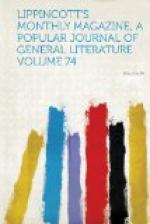The crowd on the piazza is so thick and close-packed that it is a difficult matter to move in any direction when you are once within it, but good-humor and courtesy are universal. An Italian crowd is always the best-behaved crowd in the world—partly, I take it, from the natural patience of the people, and the fact that nobody is ever in a hurry to move from the place in which he may happen to be; and partly as a consequence of the general sobriety. Even on such a night of saturnalia as this of the Befana very little drunkenness is to be seen. Although the crowd is so dense that every one’s shoulder is closely pressed against that of his neighbor, there is a great deal of dancing going on. Here and there a ring is formed, carved out, as it were, from the solid mass of human beings, in which some half dozen couples are revolving more or less in time to the braying of a bagpipe or scraping of a fiddle, executing something which has more or less semblance to a waltz. The mode in which these rings are formed is at once simple and efficacious. Any couple who feel disposed to dance link themselves together and begin to bump themselves against their immediate neighbors. These accept the intimation with the most perfect good-humor, and assist in shoving back those behind them. A space is thus gained in the first instance barely enough for the original couple to gyrate in. But by violently and persistently dancing up against the foremost of the little ring the area is gradually enlarged: first one other couple and then another are moved to follow the example, and they in their turn assist in bumping out the limits of the ring till it has become some twenty feet or so in diameter. These impromptu ball-rooms rarely much exceed that size, but dozens of them may be found in the course of one’s peregrinations around the large piazza. The occupants of some of them will be found to consist of town-bred Romans, and those of others of people from the country. There is no mistaking them one for the other, and the two elements rarely mingle together. The differences to be observed in the bearing and ways of the two are not a little amusing, and often suggestive of considerations not uninstructive to the sociologist. The probabilities are that the music in the case of the first mentioned of the above classes will be found to consist of a fiddle—in that of the latter, of a bagpipe, the old classical cornamusa, which has been the national instrument of the hill-country around the Campagna for it would be dangerous to say




